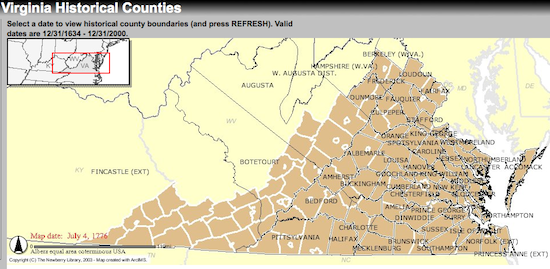Austin is the vibrant capital city of Texas with nearly two million people in its greater metropolitan area. It features a bustling economy and a thriving music scene. Austinville in Virginia, well, it doesn’t have any of that. It’s a nondescript, unincorporated Appalachian village with only 2,500 residence in its entire zip code. Yet, as improbably as it sounds, there is a direct connection between the two.
Fincastle County

Austinville seemed preordained as a place of great importance and influence. However, that happened long before the Austin family arrived on the scene. Local residents called it Lead Mines for most of the latter Eighteenth Century for the obvious reason. Then British governor Lord Dunmore created Fincastle County within the Virginia colony in 1772. He designated Lead Mines as the county seat.
Ponder the immensity of Fincastle County at the dawn of the American Revolution. It encompassed a good portion of present southwestern Virginia, some of southern West Virginia, and the entirety of Kentucky. But it didn’t last. The Americans broke it up and mothballed the name by the end of 1776. They probably did that because Dunmore named the county for his son, Lord Fincastle and it didn’t sit well with them. Dunmore had already fled for safety to New York by that time so he couldn’t do anything about it.
Lead Mines
Why would Lord Dunmore consider the Lead Mines District to be the most significant place in such a huge expanse of territory? Because of the mines. Lead was a malleable, versatile metal and an important commodity in the colonies and elsewhere.

Settlers moved to Lead Mines during the late Colonial era, and industry followed. Shot Tower Historical State Park preserves what later became the Jackson Ferry Shot Tower. Workers poured molten lead through a sieve at the top of the tower. Lead droplets cooled into spheres as they fell through the air for 150 feet. It first fell 75 feet within the tower and then another 75 feet within a shaft descending below the tower. Then shot landed into a water reservoir at the bottom, ideally shaped by gravity for muskets.
This became a critical area during the American Revolution. A large percentage of lead shot for Continental Army muskets came from these mines and this tower.
Austinville
Lead Mines became Austinville (map) sometime after Moses Austin and his brother bought the mines and moved to the area after the war in the 1790’s, as described in Related Families of Botetourt County, Virginia:
“Moses and his wife, daughter of Benjamin Fuller, wealthy Philadelphia merchant, left their pleasant life and lovely home in Richmond to live in the tiny mining village on the south fork of the New River. Moses had knowledge and interest in lead mining, for he had worked in lead mining in Durham, Connecticut, before and during the Revolution.”
Stephen F. Austin

Stephen F. Austin, the “Father of Texas” was born in Austinville, on November 3, 1793.
The Handbook of Texas, from the Texas State Historical Association picked up the story from there. Moses was a serial entrepreneur driven by the pursuit of lead. He’s been credited as the “founder of the American lead industry”. That may not sound as impressive as Father of Texas although it’s still pretty remarkable.
He moved the family from Austinville to Spanish Upper Louisiana after a few years — near modern Potosi, Missouri (and not far from Mine La Motte mentioned in Three Notches) — where lead had been discovered and where he’d recently acquired a mining grant from the Spanish government.
Unfortunately he fell on hard times because of some bad investments. So he hatched a plan to create an American settlement in Spanish Texas as a way to restore his fortunes. Moses died of pneumonia in 1821 just a couple of months after receiving permission to form his settlement. His dying wish was to have Stephen carry onward to Texas.

Stephen of course did achieve his father’s wish and now we have Austin, the capital city of Texas. Left behind, Austinville has little more than and a patch of grass with three flags and a monument called Stephen F. Austin Memorial Park (Street View).

Leave a Reply